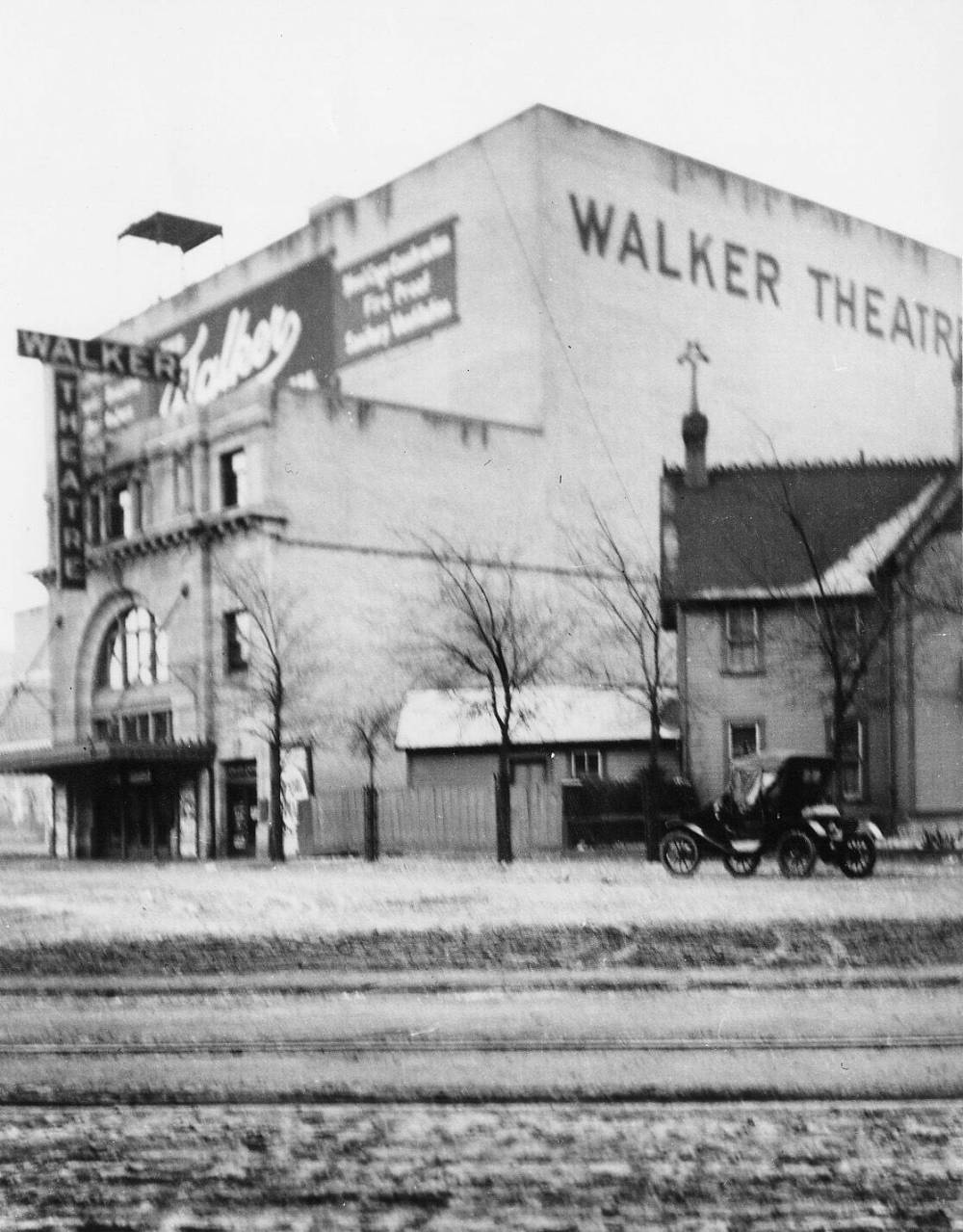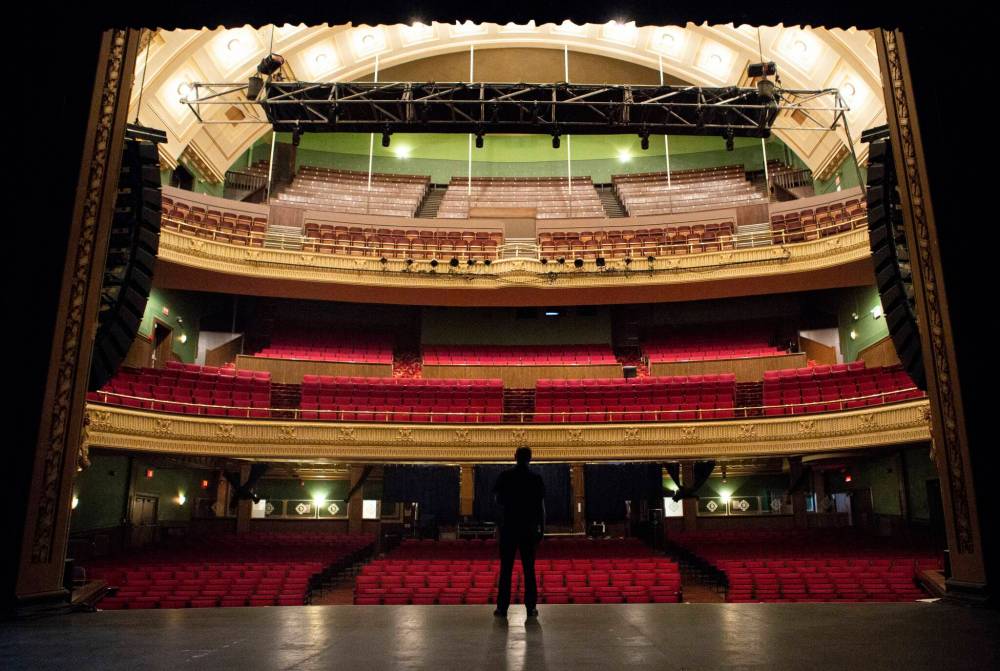Hunting for ghosts and grandeur at the Burt
Work in the 1990s revived Burton Cummings Theatre’s craftsmanship, but no sign of ill-fated actor-spectres
Advertisement
Read this article for free:
or
Already have an account? Log in here »
To continue reading, please subscribe:
Monthly Digital Subscription
$0 for the first 4 weeks*
- Enjoy unlimited reading on winnipegfreepress.com
- Read the E-Edition, our digital replica newspaper
- Access News Break, our award-winning app
- Play interactive puzzles
*No charge for 4 weeks then price increases to the regular rate of $19.00 plus GST every four weeks. Offer available to new and qualified returning subscribers only. Cancel any time.
Monthly Digital Subscription
$4.75/week*
- Enjoy unlimited reading on winnipegfreepress.com
- Read the E-Edition, our digital replica newspaper
- Access News Break, our award-winning app
- Play interactive puzzles
*Billed as $19 plus GST every four weeks. Cancel any time.
To continue reading, please subscribe:
Add Free Press access to your Brandon Sun subscription for only an additional
$1 for the first 4 weeks*
*Your next subscription payment will increase by $1.00 and you will be charged $16.99 plus GST for four weeks. After four weeks, your payment will increase to $23.99 plus GST every four weeks.
Read unlimited articles for free today:
or
Already have an account? Log in here »
Hey there, time traveller!
This article was published 23/10/2023 (778 days ago), so information in it may no longer be current.
In stories, legends and rumours, old buildings and hauntings often go together.
Even Canada’s Historic Places, a government initiative that brings together information and programming around our country’s heritage structures, admits this: “The hidden spaces of a dark theatre, the quiet halls of a historic hotel or the vacant cells of an abandoned prison can be eerie enough on their own, but add reports of mysterious noises, ghost-like apparitions and unexplainable phenomena and these heritage places become downright frightening — frighteningly fascinating.”
Winnipeg’s Burton Cummings Theatre, originally the Walker Theatre, is reputed to be haunted by renowned English acting couple Laurence Irving and Mabel Hackney.
MIKAELA MACKENZIE / WINNIPEG FREE PRESS FILES
‘Rehabilitating the theatre was a challenge and a wonderful experience,’ Susan Algie, now the director of the Winnipeg Architecture Foundation, says of the 1990s work on what would be renamed the Burton Cummings Theatre in 2002.
On the 100th anniversary of their 1914 deaths, then-Free Press theatre critic Kevin Prokosh looked into the origin of these tales, relating how the pair finished a successful North American tour with a performance at the Walker and then left Winnipeg for Quebec City to book passage home. Their ship, the Empress of Ireland, was rammed by a Norwegian vessel on the St. Lawrence River in an accident that took 1,012 lives.
Ghost hunters believe the couple’s spirits returned to the Walker as the site of their last acting triumph and as the fulfilment of a promise: when Irving took his Walker Theatre curtain call, he vowed to come back.
Years of stories about strange nocturnal noises and visions mean the Smith Street theatre has joined our city’s unofficial list of haunted heritage buildings, including the nearby Masonic Temple, the Fort Garry Hotel and the Vaughan Street Jail.
For non-believers, there’s another way of looking at the spookiness of old buildings. They may not be haunted by ghosts, but they are possessed by their past lives, by their accumulated layers of time and history, by the experiences of the men and women who have lived and worked in them.
Take the Walker, which opened in 1907 and is now designated as a historic site by all three levels of government. Commissioned by entrepreneur and impresario Corliss Powers Walker and designed by Montreal architect Howard C. Stone, the structure saw heights of glamour and grandeur at the turn of the 20th century but took a downturn during the Depression, eventually closing and later being seized by the city for unpaid taxes.
SUPPLIED
Ghost hunters believe the spirits of Mabel Hackney and Laurence Irving returned to the Burt, the site of their last acting appearance before they died in 1914 in the sinking of the Empress of Ireland.
The building has been a so-called “legitimate theatre” (in contrast to vaudeville), presenting comedies, dramas, operas, ballets and lectures as part of the Red River Valley theatre circuit. From 1945 to 1990, it operated as an Odeon movie theatre, and since ’91, it’s been open once again as a centre for the performing arts, taking the name the Burton Cummings Theatre in 2002.
The Burt, as it’s often called now, holds moments of significant social history. In the cultural life of our city, the theatre’s early heyday saw regular stops by English repertory troupes and travelling opera companies. A particularly grandiose 1909 production of Ben-Hur involved a dozen live horses enacting the chariot race scene.
The 1912 debate on women’s rights between premier Rodmond Roblin and suffragist Nellie McClung and the 1914 Women’s Parliament, both held at the Walker, advanced the cause of women’s voting rights in Manitoba.
A mass meeting of union workers and political activists on December 1918, attended by more than 1,700 people, helped set the stage for the Winnipeg General Strike in 1919.
Famous visiting speakers include Sherlock Holmes creator Arthur Conan Doyle (who in 1923 lectured on the “tangible proof” of survival of the spirit after death).

Through the Walker’s ensuing up-and-down decades, many of the building’s architectural features were buried. The conversion to a single-screen cinema cut up and covered over much of its original beauty. An extensive restoration project, undertaken from 1992 to 1997, required some architectural digging, following the traces left in the building to rediscover its former glory.
Susan Algie, now the director of the Winnipeg Architecture Foundation, worked on the project as a heritage resource planner for Parks Canada, along with David Firman, an architect with the Heritage Resources branch of Manitoba.
“Rehabilitating the theatre was a challenge and a wonderful experience,” Algie recalls in a recent email interview. “David Hannivan and Associates from Toronto were hired to do an investigation of the theatre and its finishes. They’re one of the most experienced historic theatre specialists in North America. The report contained their research into the finishes for the walls, floors and ceiling and provided information for the missing parts.”
Looking at the long, layered history of the building explains some puzzling features, like the way its detailed entranceway seems stranded in a flat expanse of ordinary brick. C.P. Walker originally envisioned a bigger structure, and in the original plan, the exterior wall would have been covered over by a more elaborate façade.
As Algie explains, “Mr. Walker intended to build a hotel as part of the complex. Unfortunately, the economy suffered a major downturn, and he didn’t proceed with the project. What you now see as the entrance was to be part of a very much larger building.”

ANDREW RYAN / WINNIPEG FREE PRESS FILES
As when it opened in 1907 as the Walker Theatre, the Burt is still renowned for its ornamentation inside and out.
That utilitarian exterior is also at odds with the interior’s lofty spaces and decorative flourishes, which once helped patrons feel they were entering a rarified realm of high art. The lobby was finished with Italian marble, velvet carpets and silk tapestries. The theatre area combined a grand sense of space with lovely small details.
The huge stage — large enough for those BenHur-like spectacles — was framed by a high proscenium arch, adorned with a frieze of acanthus and oak leaves. The arch’s elegant curves were echoed in the soaring vaulted ceiling and in the arches of the plush boxes, which were boldly cantilevered so they require no supporting columns, keeping sightlines clear.
As it reached back through the decades, the ’90s restoration process required some revived historical craftsmanship.
“Alfred Widmer had been brought to Winnipeg to work on the exterior decoration on Fort Garry Place,” Algie recounts. “Trained in Germany as a historical building conservator, he was engaged to work on the Walker Theatre. He replicated missing plaster decoration, did specialized painting and restored the very unique fire and scenic curtains.”
Alongside the Walker’s lavish ornamentation, the building’s key functional features included what was at the time state-of-the-art fireproofing through materials and design.
WAYNE GLOWACKI / WINNIPEG FREE PRESS FILES
While a ‘ghost light’, seen at the Burt in 2014, is a long held theatre tradition, Susan Algie, who participated in the 1990s restoration, does not believe in ghosts: ‘Nope.’
The Walker was advertised as “Absolutely Fireproof,” and C.P. Walker was clearly haunted by the threat of the catastrophic theatre fires that were distressingly common in the 1800s. (The phrase “shouting ‘Fire!’ in a crowded theatre” might have roots in real-life fears about these conflagrations, which often resulted from a treacherous combination of open light sources, highly flammable building materials, large audiences and cramped, narrow exit routes.)
Algie’s favourite feature at the Walker is “the gods,” the steeply slanted bench seats at the top of the theatre where the admission was 25 cents. “There was (and is still) a separate entrance to these cheap seats. I think they tell a story about class at the time. These are the only example of these seats remaining in Canada,” Algie says.
Another standout feature is the amazing acoustics. “On my first visit, we were at the top of ‘the gods’ and a coin was dropped on the stage, and you could hear it,” Algie remembers.
Algie got a lot of satisfaction from researching the Walker’s history. For example, she was really interested in restoring the unique stage curtains to their original state.
“One of the unfortunate results of the conversion to a movie theatre is that the fire curtain was painted over for about a four-foot strip at the bottom. This was to make a suitable frame for the film screen,” she says.
MIKE APORIUS / WINNIPEG FREE PRESS FILES/p>
Despite extensive restoration in the 1990s, some parts of the Burton Cummings Theatre, seen here in 2009, are showing their age.
“We wanted to restore the drawing on the curtain but couldn’t find an image of the original. I searched for a long time and managed to find a newspaper image the night before it would have been too late — so (it was)] a thrill to be able to have the fire curtain fully restored.”
Algie herself doesn’t believe in ghosts. Asked if the theatre is haunted, she replies simply, “Nope.” But the restoration process can involve a kind of architectural ghost hunting, sifting through layers of time and change to find the true spirit of a building.
alison.gillmor@winnipegfreepress.com
MIKAELA MACKENZIE / WINNIPEG FREE PRESS FILES
Seen here in 2021, the Burton Cummings Theatre, or the Burt, was originally called the Walker Theatre, commissioned by entrepreneur and impresario Corliss Powers Walker.
MIKAELA MACKENZIE / WINNIPEG FREE PRESS FILES
The steeply raked bench seating at the top of the Burton Cummings Theatre is still called ‘the gods’ and originally sold for 25 cents per seat.

Studying at the University of Winnipeg and later Toronto’s York University, Alison Gillmor planned to become an art historian. She ended up catching the journalism bug when she started as visual arts reviewer at the Winnipeg Free Press in 1992.
Our newsroom depends on a growing audience of readers to power our journalism. If you are not a paid reader, please consider becoming a subscriber.
Our newsroom depends on its audience of readers to power our journalism. Thank you for your support.



